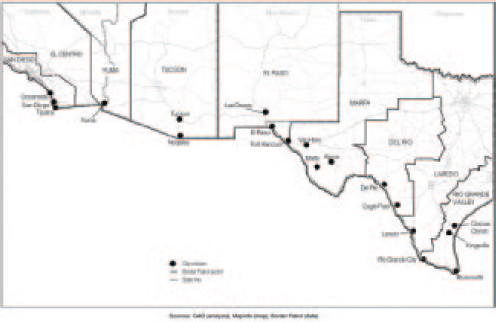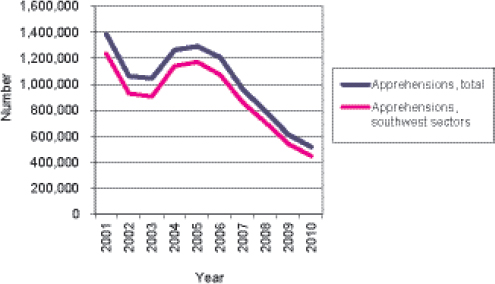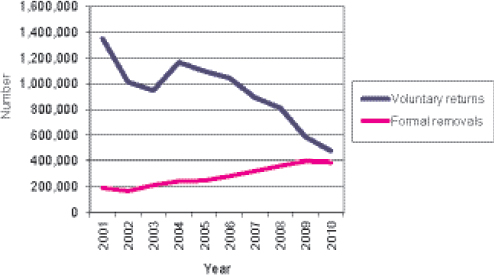The U.S. Department of Homeland Security (DHS) is charged with securing and managing the nation’s borders. The Office of Field Operations within Customs and Border Protection is responsible for enforcing immigration laws at official ports of entry, while the U.S. Border Patrol (USBP)—which is also part of Customs and Border Protection—enforces immigration laws between ports of entry. Immigration violations in the interior of the country, away from the border, fall under the purview of Immigrations and Customs Enforcement.
According to published DHS statistics on “deportable aliens located,” over the last decade USBP apprehensions in the southwest sectors (Figure 1-1) have accounted for between 86 and 91 percent of total apprehensions of unauthorized immigrants (U.S. Department of Homeland Security, 2011b). Apprehensions in the southwest sectors have fallen by approximately 64 percent between 2001 and 2010, as shown in Figure 1-2. This decline has coincided with stepped-up immigration enforcement efforts by DHS. The number of USBP agents nearly doubled in that period, from approximately 10,000 in 2004 to more than 20,500 in 2010, and DHS has deployed thousands of technology assets (including mobile surveillance units, thermal imaging systems, non-intrusive inspection equipment, and aerial surveillance) along the U.S.–Mexico border (U.S. Department of Homeland Security, 2011a).
DHS has also implemented a variety of “consequence delivery” programs in which unauthorized immigrants are not simply “voluntarily returned” without any attendant civil or criminal consequences but instead are placed in administrative and/or legal proceedings prior to being formally
Figure 1-1 Apprehensions of unauthorized immigrants, 2001-2010.
SOURCE: Data from U.S. Department of Homeland Security, 2011b:Table 35.

Figure 1-2 U.S. Border Patrol sectors along the U.S.–Mexico border.
NOTE: The sectors are San Diego and El Centro in California; Yuma and Tucson in Arizona; and El Paso, Marfa, Del Rio, Laredo, and Rio Grande Valley in Texas.
SOURCE: U.S. Government Accountability Office, 2011b:2.
Figure 1-3 Returns and removals of unauthorized immigrants, 2001-2010.
SOURCE: Data from U.S. Department of Homeland Security, 2011b:Table 36.
removed. DHS has also expanded programs, such as Secure Communities, that screen for removable immigrants who come into contact with the criminal justice system.1 As a result of such initiatives, the number of formal removals has roughly doubled between 2001 and 2010 (Figure 1-3).2,3
During the same period, the U.S. economy shed millions of jobs, and the unemployment rate more than doubled from 4.6 percent in 2007 to 9.6 percent in 2010. The decline in employment prospects in the United States may have acted as a deterrent to immigration. Thus, the number of apprehensions may have declined even if no change occurred in DHS’s effectiveness and DHS continued to apprehend illegal crossers at the same rate as before.
To properly evaluate the effectiveness of DHS’s investments in immigration enforcement, one needs an appropriate measure (or set of measures) of the total flow of unauthorized immigrants at and between the ports of entry.
_________________
1 See National Research Council (2011:Chapter 4) for a detailed description of how the immigration enforcement system operates.
2 The total of returns and removals in Figure 1-3 exceeds the total number of apprehensions in Figure 1-1. See National Research Council (2011:48-51) for a discussion of some of the limitations of published DHS apprehensions data.
3 In fiscal 2010, approximately 75 percent of unauthorized immigrants who were voluntarily returned were Mexican nationals, while 1 percent were from Central America. In that same year, approximately 73 percent of unauthorized immigrants who were formally removed were Mexican nationals, while about 20 percent were from Central America (U.S. Department of Homeland Security, 2011b).
Trends in total apprehensions are, by themselves, inadequate because different outcomes may be given similar interpretations (Morral et al., 2011). For example, increases in border apprehensions may be suggestive of more effective enforcement as long as the underlying flow of unauthorized immigrants is declining, constant, or increasing by a smaller amount than the rise in apprehensions. However, declines in border apprehensions might also be suggestive of more effective enforcement as long as the magnitude of the decline in apprehensions is larger than the magnitude of the decline in the underlying flow of unauthorized immigrants.4 In both instances, there is an increase in the ratio of apprehensions to unauthorized crossings.5
DHS has charged the National Research Council (NRC) with providing guidance on the use of survey options and other methodologies to estimate the number of unauthorized crossings at the U.S.–Mexico border, preferably by geographic region and on a quarterly basis (see Box 1-1). The NRC appointed the Panel on Survey Options for Estimating the Flow of Unauthorized Crossings at the U.S.–Mexican Border to carry out this task. A better understanding of the magnitude, timing, and location of these flows will help DHS to better evaluate the effectiveness of its enforcement efforts, allocate its resources along the border more efficiently, and provide a more complete report to the public on the state of illegal immigration.
Effective enforcement by DHS has at least three aspects: first, stopping individuals who are in the process of attempting to enter the United States from succeeding; second, doing this so well that potential entrants stop trying and return to their homes; and third, discouraging potential migrants from even leaving their homes in order to attempt illegal entry into the United States. The focus of most DHS measurement attempts, most surveys, and this report is on the first two of these outcomes. Full assessment of enforcement success, however, would require measuring the third outcome—discouragement at the origin. The measurement of this third outcome is beyond the scope of this report. Broad surveys of the Mexican population and complex analyses of the characteristics of potential migrants would be required to assess such discouragement.
Chapter 2 of the report provides context for the use of surveys and statistical methods for estimating flows by providing an overview of recent estimates on the stocks and flows of undocumented immigrants; a brief history of unauthorized immigration and policy responses to it, including a short summary of studies looking at the effectiveness of border enforcement; and a description of the border crossing process for unauthorized
_________________
4 If enforcement efforts have a deterrent effect and cause the underlying flow of unauthorized immigrants to decline, enforcement can be regarded as effective even if the magnitude of the decline in apprehensions is smaller than the magnitude of the decline in-migration.
5 However, as suggested in the previous note, the ratio of apprehensions to border crossings may not be completely informative about the effectiveness of enforcement efforts if those efforts also have a deterrent effect on unauthorized immigration.
An ad hoc panel of experts will evaluate survey options to estimate the number of foreign nationals who attempt illegal entry across the U.S.–Mexican land border each year and/or the probability of apprehension of illegal entrants. The panel will evaluate currently available and potential survey sources for estimating the number of foreign nationals who attempt illegal entry and/or the probability of apprehension of illegal entrants. These sources will include surveys currently conducted in the United States and in Mexico by both government and nongovernment entities. As part of its evaluation, the panel may consider options for initiating new survey-based data collection, modifying existing surveys, and combining data from different sources. The panel will also review the administrative data sources that the Department of Homeland Security is currently evaluating for estimating the illegal flow in order to inform the survey options. The administrative sources include, but are not limited to, apprehension and re-apprehension rates, agency estimates, results of consequence programs, interviews with apprehended foreign nationals, and results of sensor activity. In addition to survey and administrative data, the panel may also consider various modeling methodologies. The panel will provide guidance on survey implementation and cost estimates under various options. The panel will also evaluate the possibilities of collecting information through surveys that could enable estimation of annual flow and/or the probability of apprehension of illegal entrants on a quarterly basis and for particular regions of the U.S.–Mexican border. The panel will issue a report with findings and recommendations.
migrants. Chapter 3 outlines the features of the major surveys in the United States and Mexico that collect information about migration and border crossing, and Chapter 4 lays out their usefulness and limitations for estimating flows. Chapter 5 then assesses the usefulness of DHS administrative data for measuring the flow of unauthorized migrants into the United States. Finally, Chapter 6 discusses aspects of model-based approaches that would combine information from a variety of sources, including surveys and administrative data.
The panel also notes that although the Office of Immigration Statistics in DHS is not a “statistical agency” per se, it is nevertheless considered a “statistical program” by the Office of Management and Budget (U.S. Office of Management and Budget, 2011) and, as such, would benefit from adhering to the broader principles of good statistical practice as carried out in the federal statistical system (National Research Council, 2009). The panel’s conclusions and recommendations, particularly with regard to the availability of administrative data in DHS’s enforcement database, are informed by this presumption.








